Physical Address
304 North Cardinal St.
Dorchester Center, MA 02124
The first transplantation of a human heart was performed in South Africa in 1967. By the end of the 1970s, transplantation was established as an effective therapy for end-stage cardiac failure. Over the next 30 years, improvements in donation and the preservation of organs, selection of patients, postoperative management, and treatment of rejection have resulted in markedly improved survival following transplantation in both adults and children. Consequently, orthotopic transplantation of the heart is now the standard of care for the management for some infants and children with severe forms of congenital cardiac disease and end-stage cardiomyopathy. More recently, the field has evolved further with the availability of mechanical support options as a bridge to decision and to transplantation, with a significant impact on both waiting and posttransplant survival.
The factors affecting referral and the listing of patients for cardiac transplantation are complex but include the availability and outcomes of alternative surgical strategies, availability of specific expertise, the patterns of referral to an individual center, as well as societal and individual beliefs. Analysis of the natural history and outcomes must take all these factors into account. Besides reports from single centers, there are two main sources of data on outcomes for children following listing for transplantation and after transplantation. The registry of the International Society of Heart and Lung Transplantation (ISHLT) is an international registry to which patient entry is voluntary except in the United States of America, where federal mandate requires all data from the United Network of Organ Sharing to be shared with the society's database. The second source is the Pediatric Heart Transplant Study (PHTS), a voluntary, research-based and event-driven multicenter registry. It was established in 1993 in order to capture data relative to outcomes . This source currently includes 7716 patients listed for transplantation, of whom 5586 underwent transplantation between January 1, 1993, and December 31, 2016. The data are supplied by 53 centers (48 United States and 5 international).
According to the 19th annual report of the ISHLT (2016), the number of transplantations in children performed each year has increased over the prior decade, with 586 performed in 2014 compared with 442 in 2004 ( Fig. 67.1 ). Recipient age distribution has remained stable since the mid-1990s ( Fig. 67.2 ). Geographic differences exist worldwide. For example, teenagers account for half of the recipients in Europe and other areas of the world, whereas in North America more infants undergo transplantation ( Fig. 67.3 ).
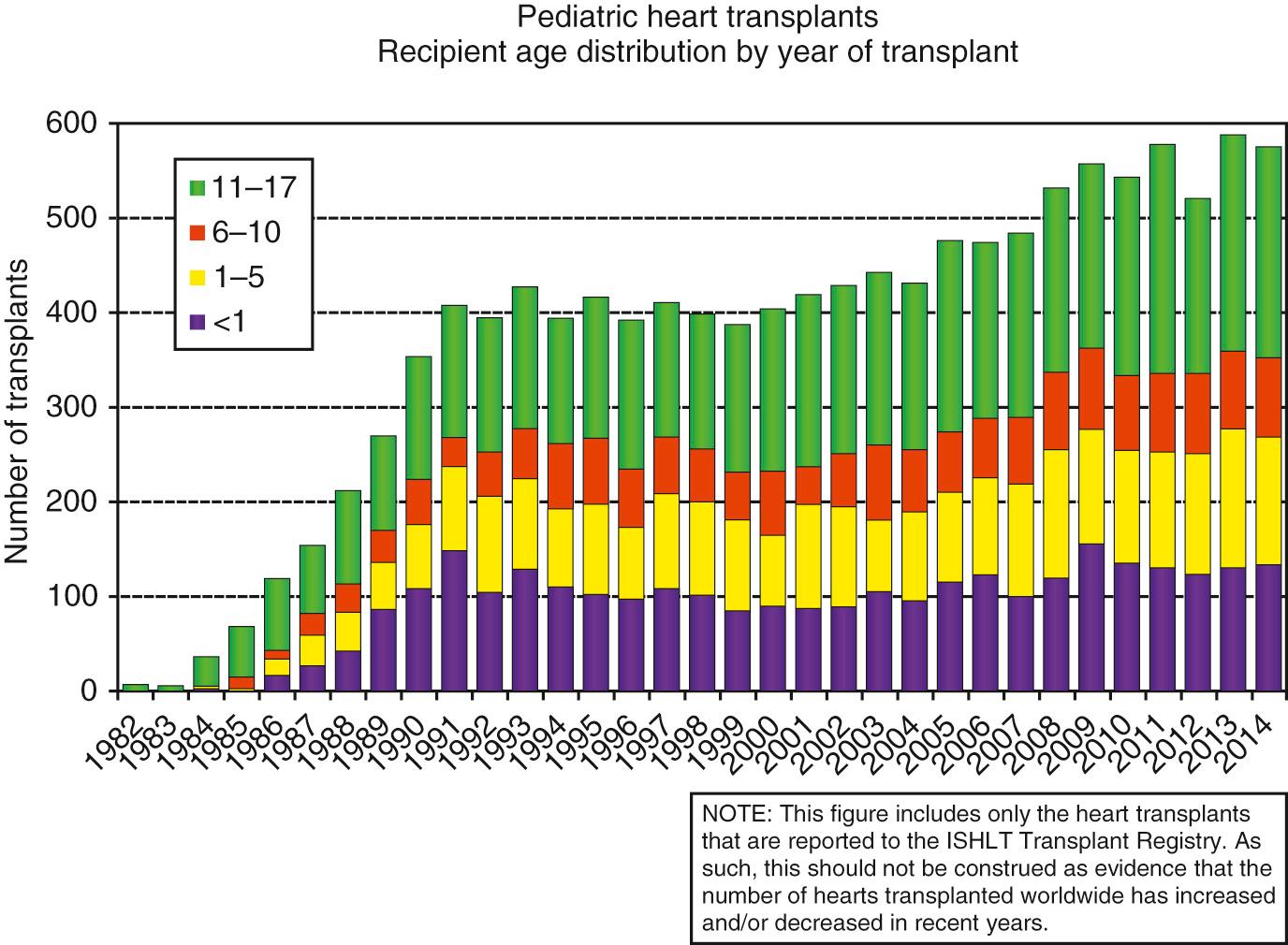
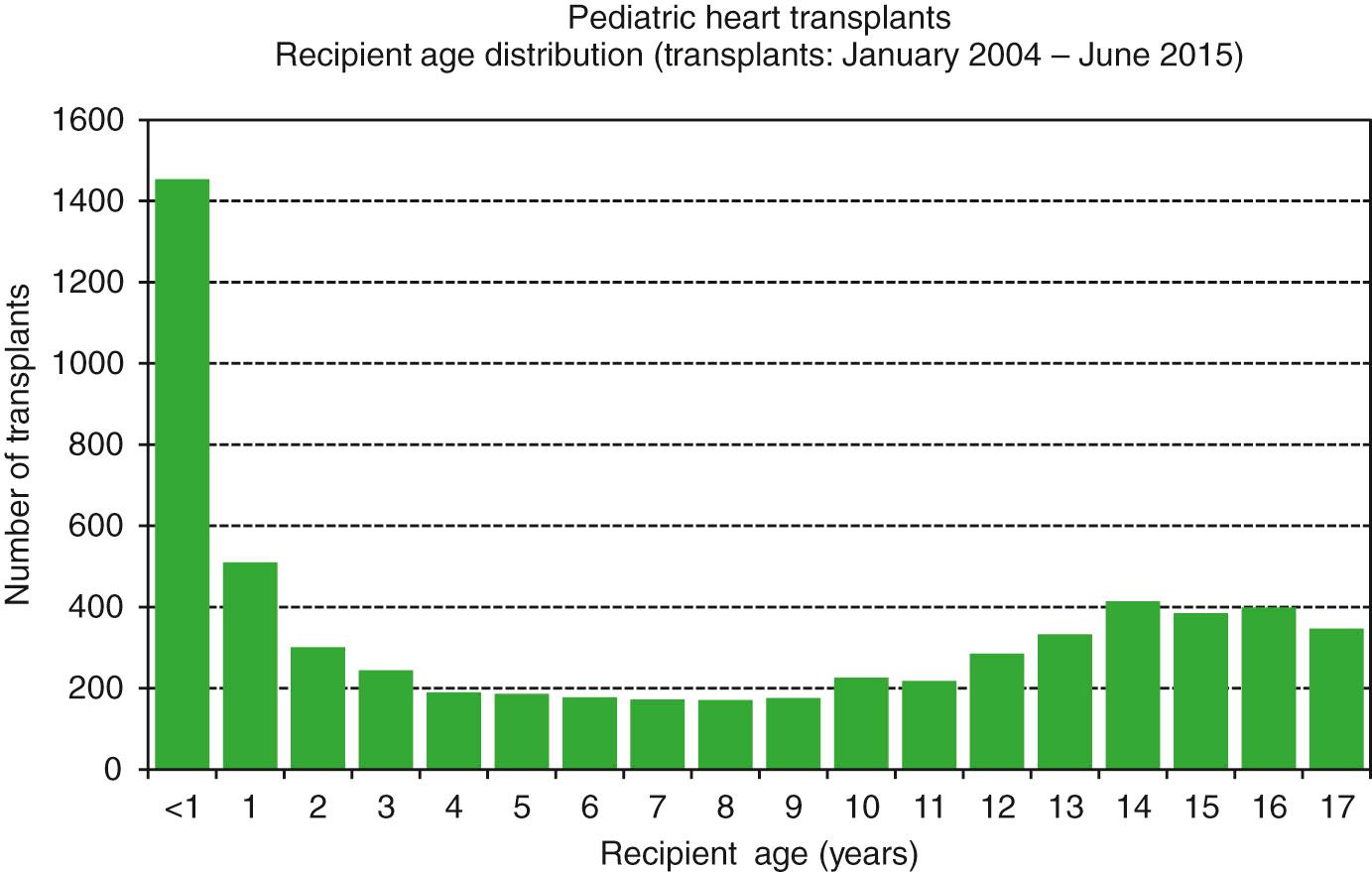
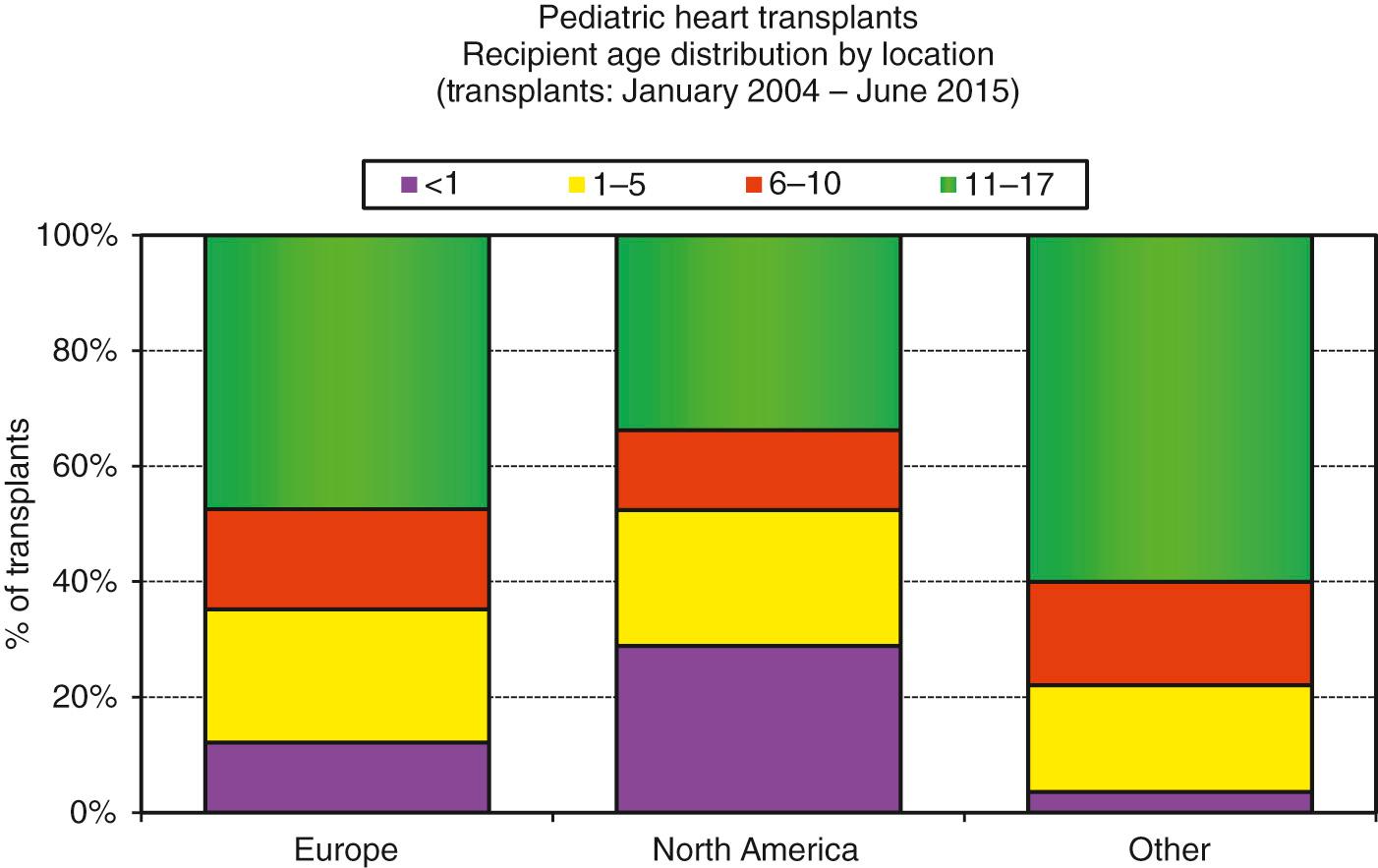
The underlying diagnoses prior to transplantation have changed over time. In infants younger than 1 year of age, congenital heart disease has remained the most common underlying diagnosis, although the proportion of infant recipients with cardiomyopathy has almost doubled over time to almost 40% in the most recent era ( Fig. 67.4 ). Cardiomyopathy remains the main diagnosis among the older age groups ( Figs. 67.5 to 67.7 ). Indications for transplantation also show geographic variation, with congenital heart disease and retransplantation both more common in North America compared with Europe and the rest of the world ( Fig. 67.8 ).
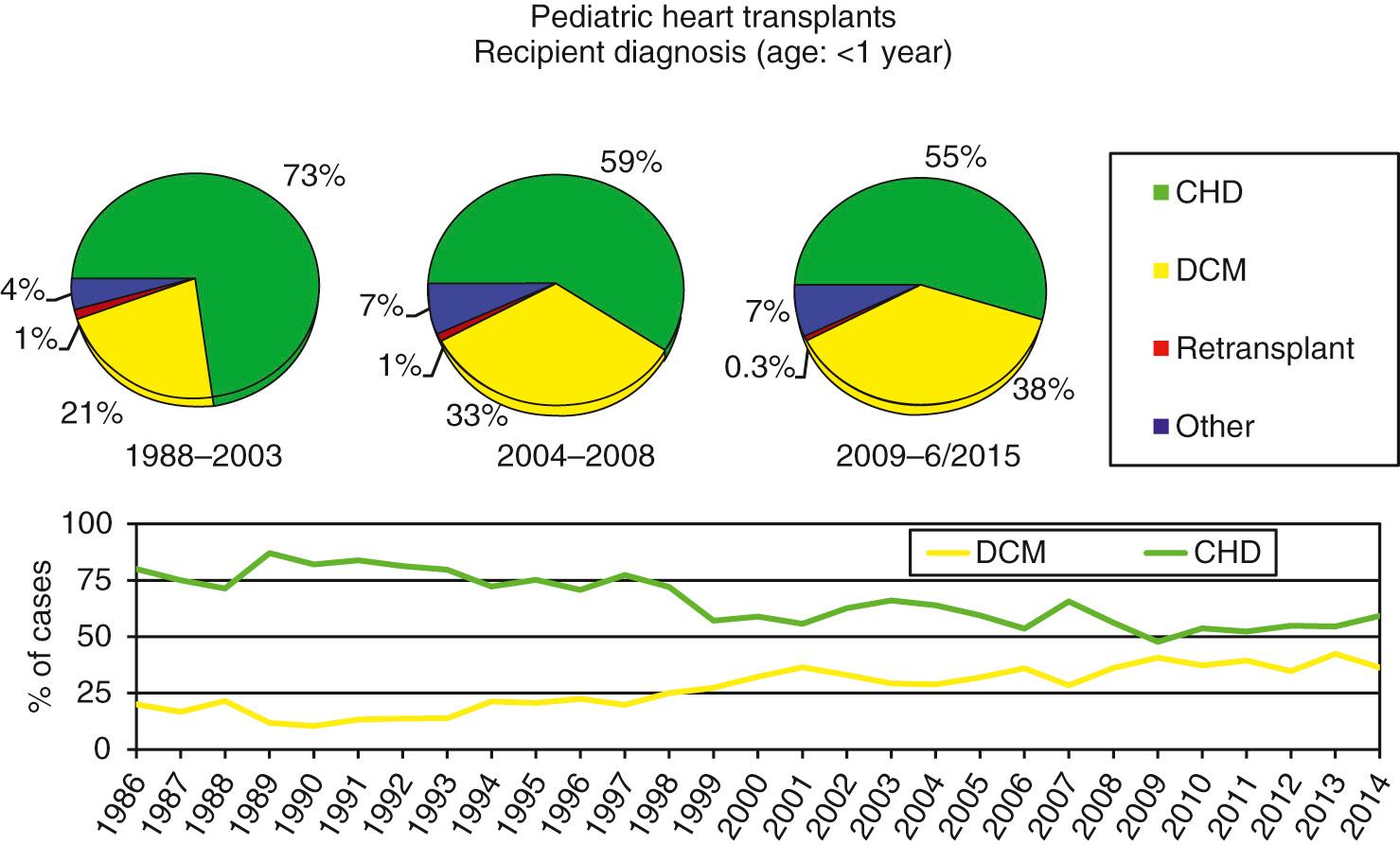
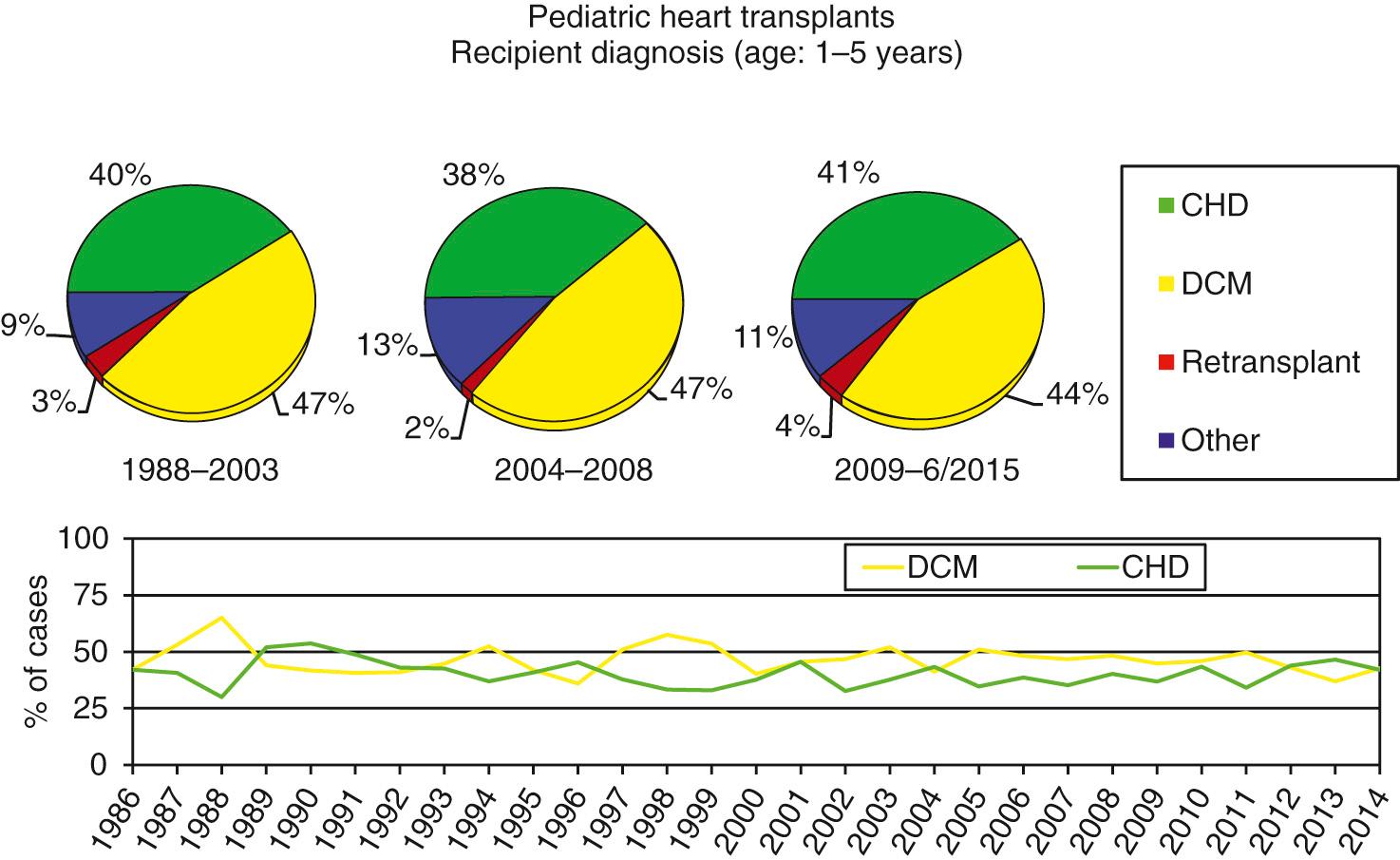
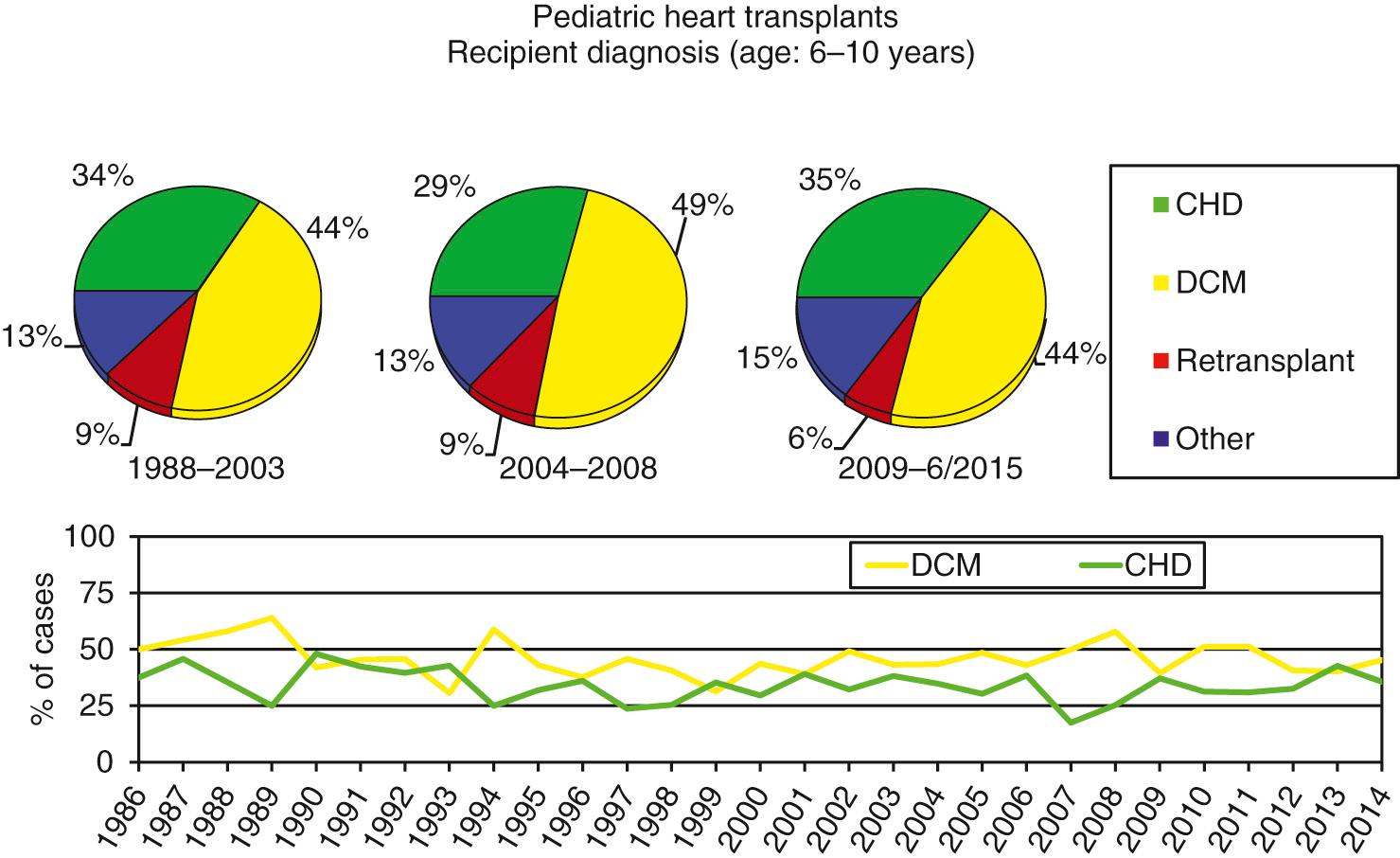
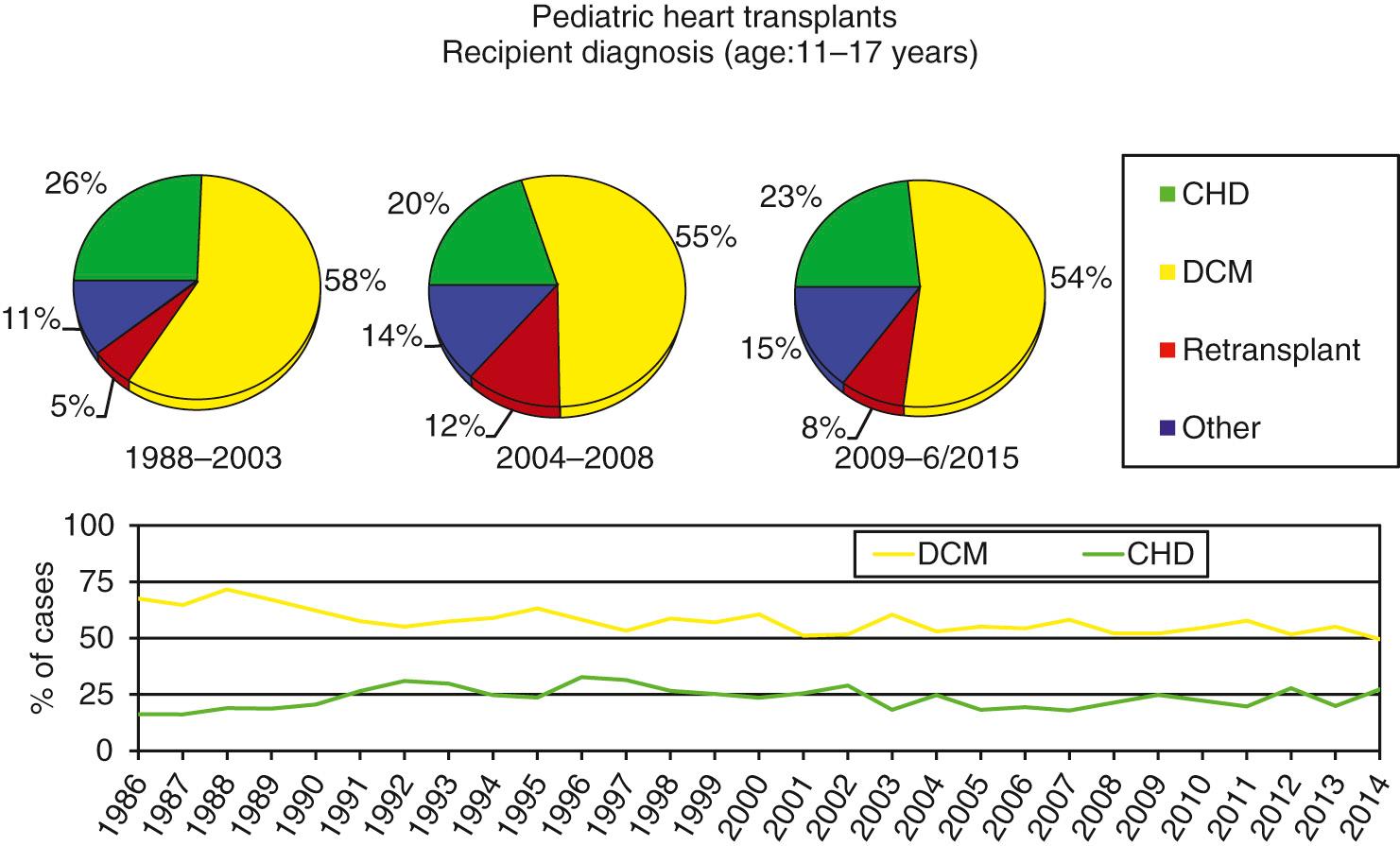
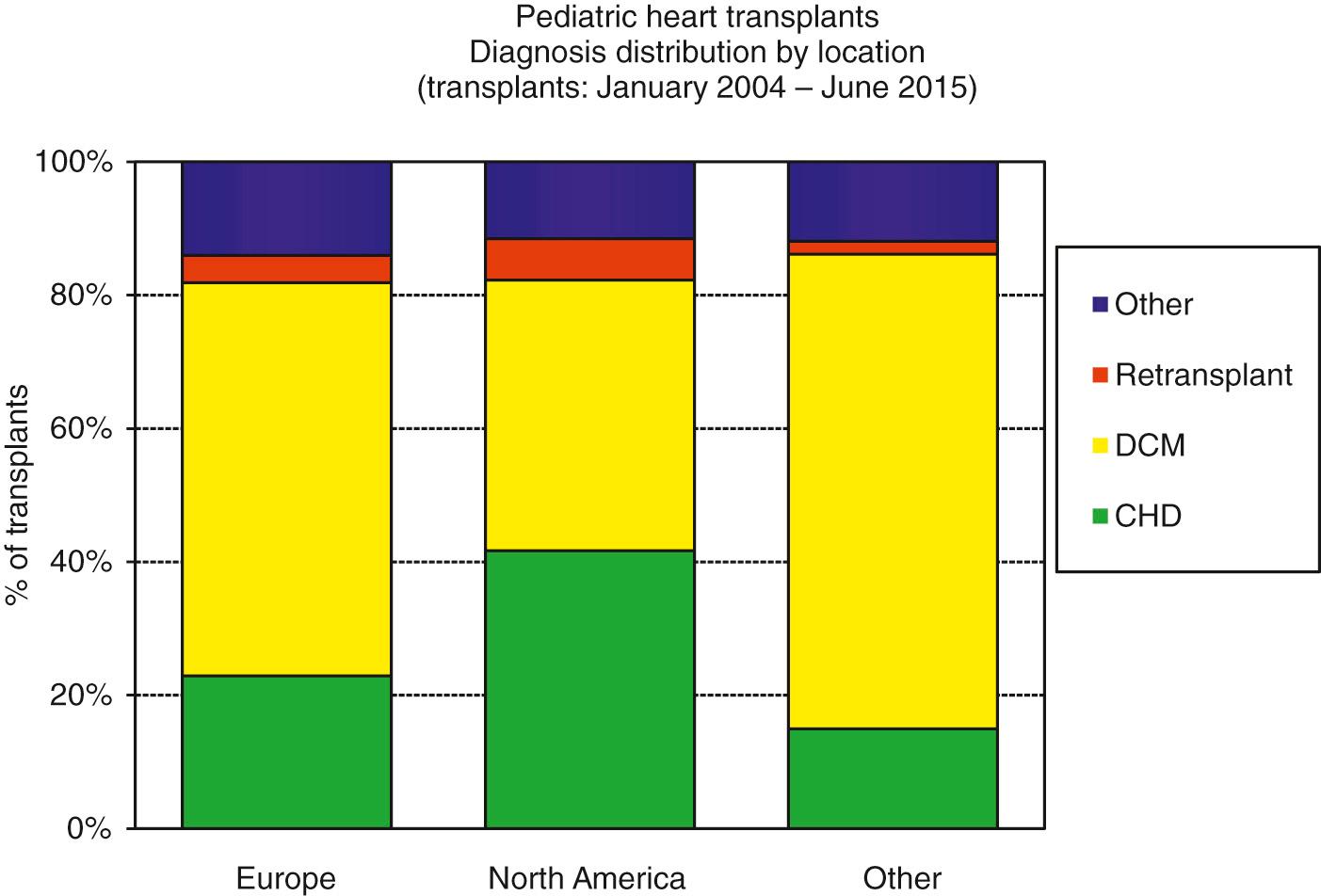
Children waiting for heart transplantation have the highest mortality in solid organ transplantation. Death while waiting reflects a combination of availability of donor organs; the medical state of the recipient; recipient age, weight and diagnosis; and availability of durable mechanical circulatory support options . Although modifying the availability of organs is difficult, knowledge of the other factors that influence mortality during the period of waiting plays an important role in decision making regarding the appropriate timing of listing a patient for transplantation.
Analysis of the US Scientific Registry of Transplant Recipients database for the period between 1999 and 2006 demonstrates mortality for all listed patients while waiting of 17% at 1 year. Recipient characteristics associated with increased waitlist mortality include extracorporeal membrane oxygenation (ECMO) support, ventilator support, listing status 1A, congenital heart disease, renal replacement therapy, and nonwhite race. A key finding is that waitlist mortality varies by as much as 10-fold based on recipient factors (5% to 39%). The mortality for infants during the period of waiting ranges from 25% to 30% and has consistently been higher than that reported for older patients . Patients with a cardiomyopathy diagnosis have better waitlist outcomes than those with congenital heart disease. Waitlist mortality even within the congenital heart disease group varies by underlying diagnosis and previous surgical palliation, especially for those with single-ventricle physiology.
In the most recent era, there has been a 50% reduction in waitlist mortality due to the advent and more widespread use of durable ventricular assist devices (VADs) for mechanical support, with a fourfold higher likelihood of surviving to transplantation.
Data from the registry of the ISHLT show that survival after transplantation in the most recent era is 91% and 81% at 1 and 5 years, respectively, with a 10-year overall survival of 66% for the prior era ( Fig. 67.9 ). Looked at in a different way, the same data show a half-life for transplantation, defined as the time to 50% survival without death or retransplantation, of 20.7 years for those aged less than 1 year at transplantation, 18.2 years for those aged from 1 to 5 years, 14 years for those aged from 6 to 10 years, and 12.7 years for those older than 11 years—numbers that continue to improve almost annually ( Fig. 67.10 ). These differences are even more marked when conditional survival is examined, which excludes mortality related to the procedure itself, with a notable era effect ( Figs. 67.11 and 67.12 ). Infants and neonates are relatively protected from later complications, whereas adolescents, who have lower mortality over the short term, are at increased risk of death or the need for retransplantation during long-term follow-up.

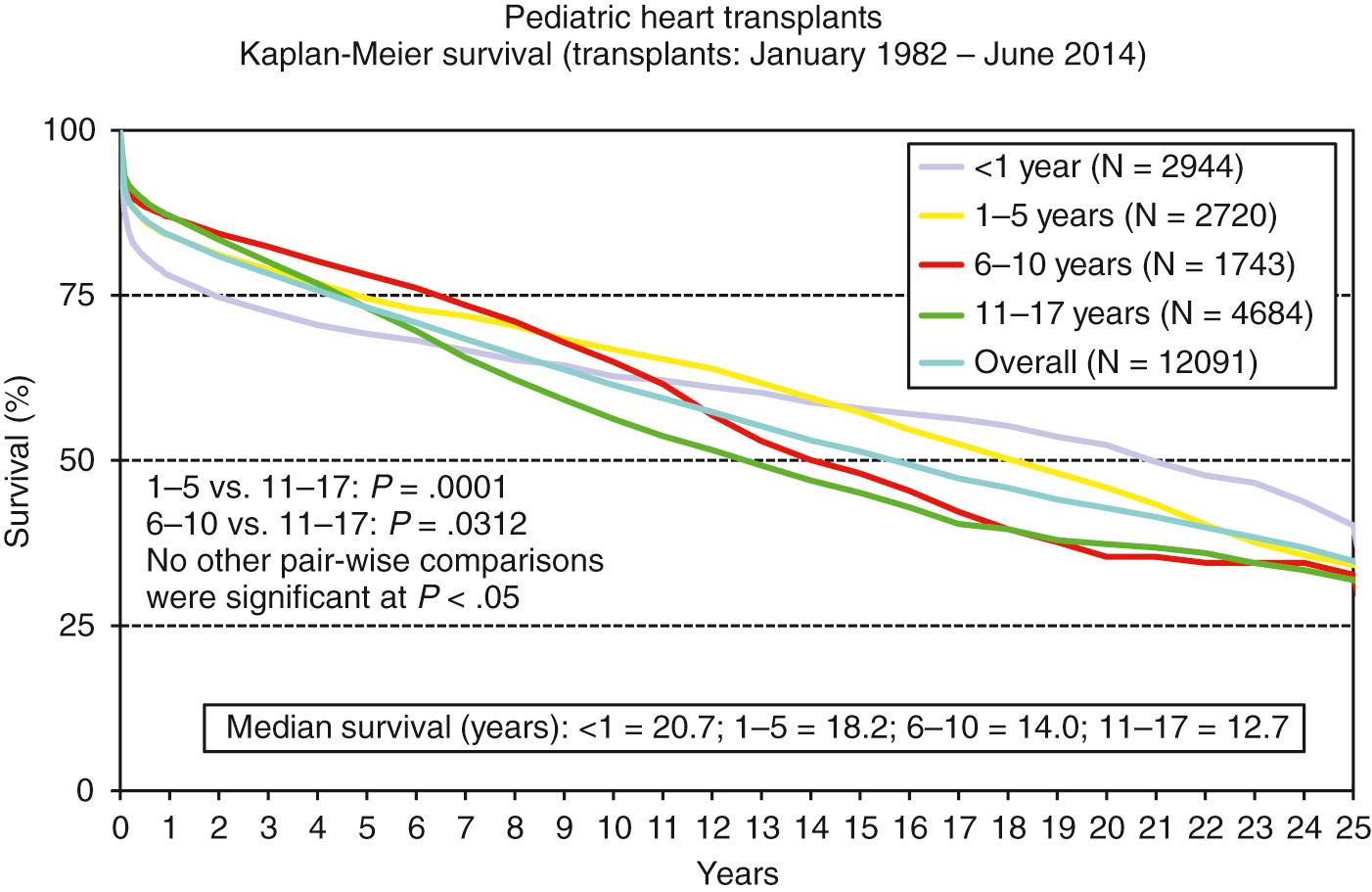
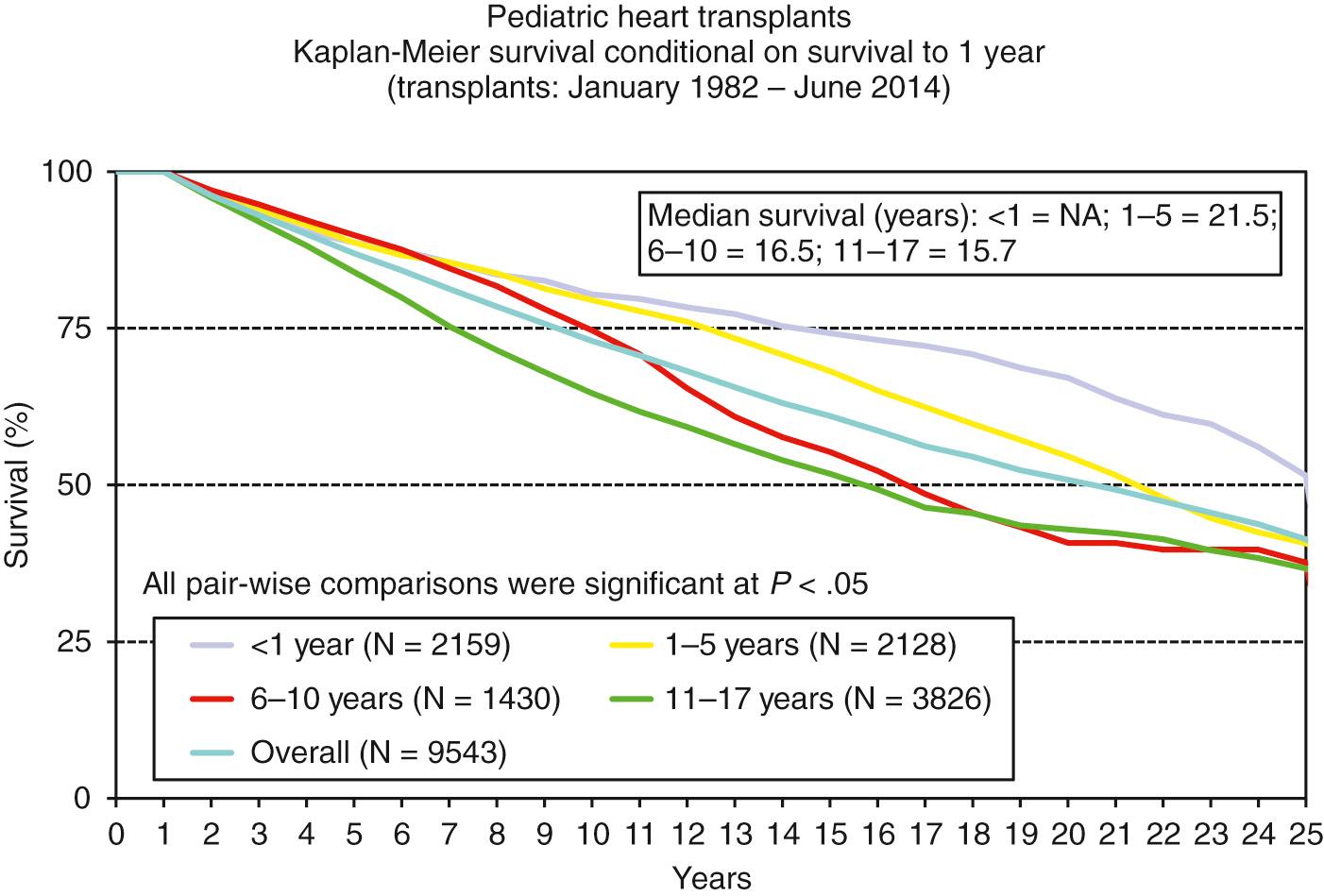
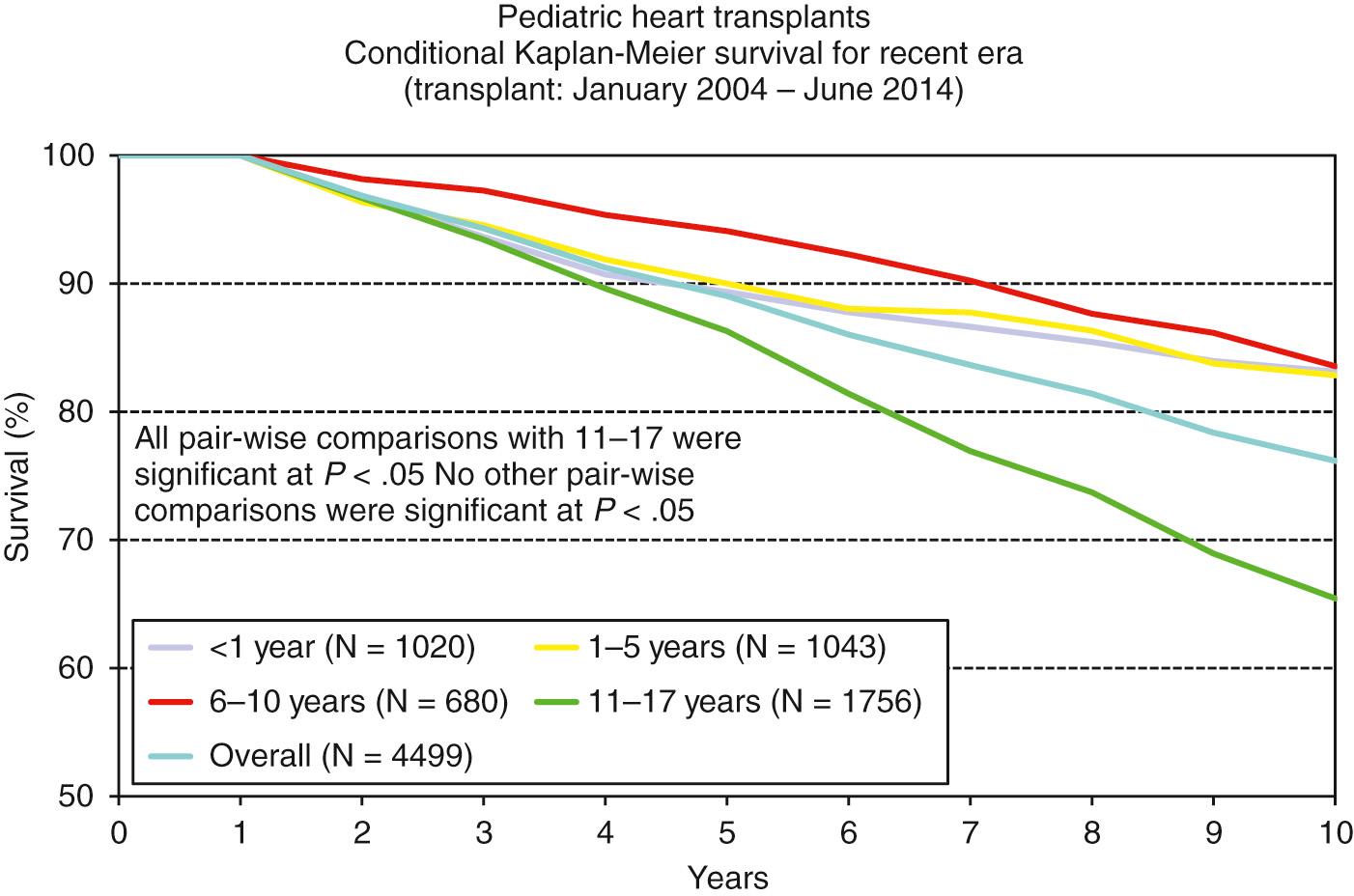
Looking more closely at the effect of era, significant improvements in survival continue to be noted, primarily related to a reduction in mortality immediately subsequent to transplantation (see Fig. 67.9 ). Conditional survival for the different age groups within the period from 2004 to 2014 amplifies the difference between infants, children, and adolescents, with infants and children having a conditional survival at 10 years of 83%, whereas the survival of adolescents is approximately 65% (see Fig. 67.12 ).
The diagnosis before transplantation also modifies survival. There is a significantly higher early mortality for patients with congenital heart disease versus those transplanted for cardiomyopathy, and this is true across all age groups . Posttransplant outcomes for patients bridged with VAD support are equivalent to outcomes without mechanical support in the current era and significantly better than outcomes for patients bridged with ECMO support ( Fig. 67.13 ).
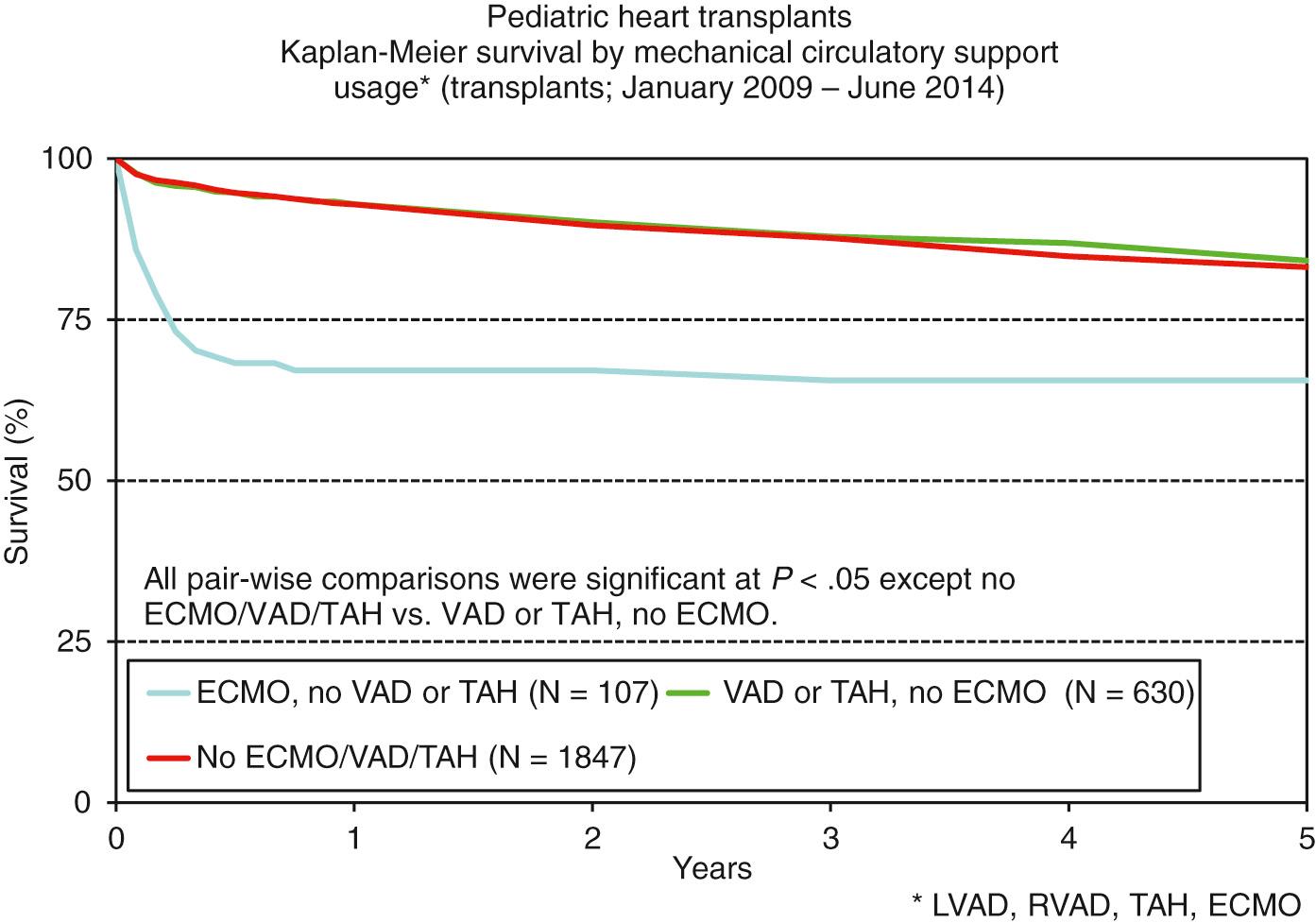
The risk factors for death in the first year following heart transplantation during childhood are outlined in Table 67.1 . They include a diagnosis of congenital heart disease, need for dialysis or extracorporeal mechanical support, mechanical ventilation before transplantation, infection, and retransplantation. Continuous variables that incur risk include ischemic time, donor weight, estimated glomerular filtration rate, and pediatric center volume. Owing to the longevity of the registry, risk factors for mortality at 5, 10, and 15 years can now be determined in a large number of childhood heart transplant patients and are summarized in Table 67.2 . Data from the PHTS were used to identify pretransplant factors by cardiac diagnosis (cardiomyopathy vs. congenital heart disease) to model risks of graft loss. Risk factors common to both diagnostic groups included markers of renal function and elevated panel reactive antibodies (PRAs, see further on). Independent risk factors for patients with congenital heart disease only included ventilator dependency and low recipient body surface area. The resultant risk prediction model for cardiomyopathy performed well, but that for congenital heart disease had limited ability to predict outcomes.
| Risk Factor | N | Hazard Ratio (95% CI) | P value |
|---|---|---|---|
| Infection requiring IV drug therapy within 2 weeks of Tx | 681 | 1.36 (1.10–1.68) | .005 |
| Ventilator | 826 | 1.41 (1.1.3–1.76) | .002 |
| Donor cause of death: cerebrovascular vs. trauma | 396 | 1.59 (1.20–2.09) | .001 |
| Diagnosis: CHD vs. DCM | 1979 | 1.91 (1.46–2.52) | <.0001 |
| Diagnosis: ReTx vs. DCM | 304 | 2.23 (1.53–3.25) | <.0001 |
| Recipient dialysis | 146 | 2.36 (1.57–3.57) | <.0001 |
| ECMO: ECMO/CHD vs. no ECMO | 145 | 2.42 (2.42–3.35) | <.0001 |
| Time Posttransplant | MODEL a | ||||||
|---|---|---|---|---|---|---|---|
| 1 Year by Recipient Age Group | 5 Year | 10 Year | 15 Year | ||||
| <1 Year | 1–5 Years | 6–10 Years | 11–17 Years | ||||
| Diagnosis: DCM vs. CHD | 0.338 | ||||||
| Diagnosis: CHD vs. DCM | 1.88 | 1.963 | 1.595 | 1.390 | 1.145 | ||
| Diagnosis: retransplantation vs. DCM | 1.943 | 1.822 | 1.496 | 1.634 | |||
| Diagnosis/device: VAD/not CHD vs. no device | 2.155 | ||||||
| Diagnosis/device: ECMO/not CHD vs. no device | 2.563 | ||||||
| Diagnosis/device: ECMO/CHD vs. no device | 3.521 | 1.956 | |||||
| Diagnosis/device: ECMO vs. no device | 1.363 | ||||||
| Diagnosis/device: CHD/no device vs. DCM/no device | 2.267 | ||||||
| Diagnosis/device: CHD/ECMO vs. DCM/no device | 3.042 | ||||||
| Diagnosis/device: CHD/MCSD vs. DCM/no device | 7.614 | ||||||
| Infection requiring IV drug therapy (within 2 weeks of Tx) | 1.438 | 1.268 | |||||
| Recipient transfusions | 1.854 | ||||||
| Ventilator | 1.766 | 1.820 | 1.270 | 1.176 | |||
| Recipient dialysis | 2.842 | 4.60 | 1.665 | ||||
| Pre-Tx cerebrovascular event | 0.466 | ||||||
| Most recent PRA 10+% | 1.287 | 1.394 | |||||
| Recipient steroids | 1.278 | ||||||
| Donor CMV+/recipient CMV– vs. not mismatched | 0.604 | ||||||
| Donor clinical infection | 0.577 | ||||||
| Donor cause of death: cerebrovascular vs. head trauma | 1.941 | ||||||
| TRANSPLANT ERA | |||||||
| 1995–96 vs. 1989–90 | 0.797 | ||||||
| 1996–97 vs. 1994–95 | 0.841 | ||||||
| 1997–98 vs. 1989–90 | 0.690 | ||||||
| 1998–99 vs. 1994–95 | 0.842 | ||||||
| 2000–01 vs. 1994–95 | 0.753 | ||||||
| 2002–04 vs. 1994–95 | 0.698 | ||||||
| 2007–09 vs. 1999–2000 | 0.752 | ||||||
| Male donor/female recipient vs. male donor/male recipient | 1.430 | 1.238 | |||||
| Female donor/female recipient vs. male donor/male recipient | 1.250 | ||||||
a 1 year: January 1, 2003 to December 31, 2013; 5 years: January 1, 1999 to December 31, 2009; 10 years: January 1, 1994 to December 31, 2004; 15 years: January 1, 1989 to December 31, 1999.
Posttransplant factors associated with graft loss and death include cardiac allograft vasculopathy (CAV) , rejection, posttransplant lymphoproliferative disorder (PTLD), and infection (see later); in addition, attempts have been made to devise and validate a risk-prediction model to predict graft loss.
The causes of death reported to the ISHLT registry, stratified by time posttransplant, are summarized in Table 67.3 . Rejection, infection, primary graft failure, and sudden cardiac death are the major causes of death in children within the first 5 years . Allograft vasculopathy accounted for about seven-tenths of deaths between 5 and 10 years after transplantation ( Fig. 67.14 ).
| Cause of Death | 0–30 Days ( N = 256) | 31 Days– 1 Year ( N = 297) | >1–3 Years ( N = 236) | >3–5 Years ( N = 204) | >5–10 Years ( N = 366) | >10 Years ( N = 408) |
|---|---|---|---|---|---|---|
| CAV | 4 (1.6%) | 9 (3.0%) | 33 (14.0%) | 36 (17.6%) | 75 (20.5%) | 99 (24.3%) |
| Acute rejection | 17 (6.6%) | 45 (15.2%) | 42 (17.8%) | 30 (14.7%) | 39 (10.7%) | 21 (5.1%) |
| Lymphoma | 0 | 5 (1.7%) | 9 (3.8%) | 9 (4.4%) | 22 (6.0%) | 26 (6.4%) |
| Malignancy, other | 0 | 3 (1.0%) | 3 (1.3%) | 1 (0.5%) | 7 (1.9%) | 17 (4.2%) |
| CMV | 0 | 6 (2.0%) | 0 | 0 | 0 | 0 |
| Infection, non-CMV | 16 (6.3%) | 37 (12.5%) | 14 (5.9%) | 12 (5.9%) | 20 (5.5%) | 24 (5.9%) |
| Graft failure | 98 (38.3%) | 61 (20.5%) | 89 (37.7%) | 76 (37.3%) | 145 (39.6%) | 135 (33.1%) |
| Technical | 20 (7.8%) | 2 (0.7%) | 0 | 1 (0.5%) | 4 (1.1%) | 5 (1.2%) |
| Other | 23 (9%) | 21 (7.1%) | 15 (6.4%) | 14 (6.9%) | 19 (5.2%) | 24 (5.9%) |
| Multiple organ failure | 30 (11.7%) | 64 (21.5%) | 13 (5.5%) | 8 (3.9%) | 14 (3.8%) | 25 (6.1%) |
| Renal failure | 1 (0.4%) | 4 (1.3%) | 1 (0.4%) | 1 (0.5%) | 1 (0.3%) | 12 (2.9%) |
| Pulmonary | 10 (3.9%) | 29 (9.8%) | 11 (4.7%) | 9 (4.4%) | 11 (3.0%) | 7 (1.7%) |
| Cerebrovascular | 37 (14.5%) | 11 (3.7%) | 6 (2.5%) | 7 (3.4%) | 9 (2.5%) | 13 (3.2%) |
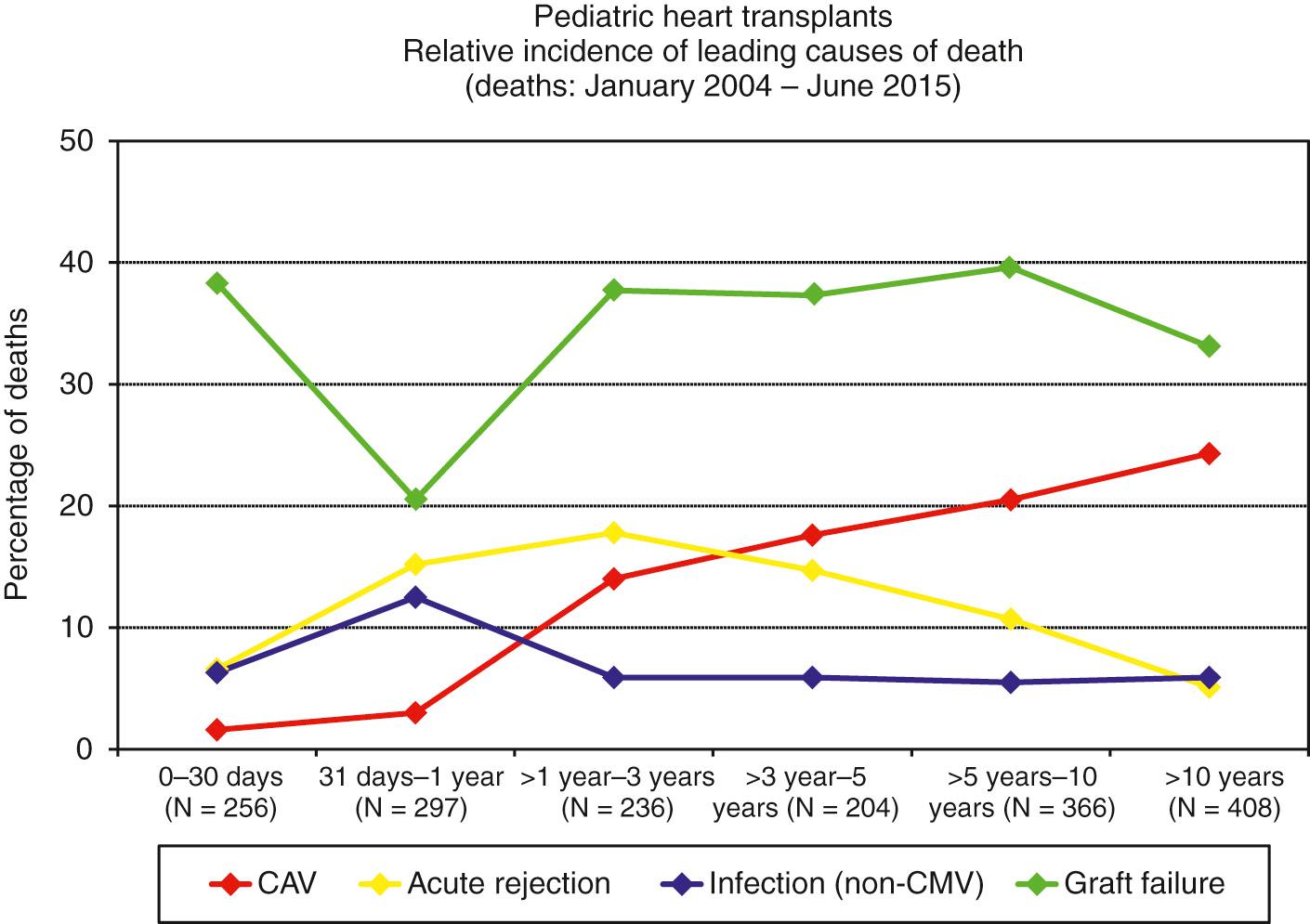
Careful assessment prior to transplantation is required in order, first, to identify potentially reversible causes of end-stage heart failure and optimize management; second, to identify indications for transplantation; and third, to identify confounding factors or contraindications that may preclude candidacy for transplantation. The general components required for a comprehensive assessment prior to transplantation are outlined in Box 67.1 . In addition to assessment of the heart by the cardiothoracic surgeons and transplant cardiologists, consultations from an interdisciplinary team—including social workers, psychiatrists, physiotherapists, pharmacists, dieticians, occupational therapists, specialists in adolescent medicine, and key medical services including nephrology and anesthesia—are critical to the process. For example, renal and/or hepatic dysfunction has been associated with a reduction in intermediate and long-term survival and must therefore be integrated into the assessment of risk. Psychosocial assessment of the entire family is paramount. This is especially important in assessing adolescents, given the increasing awareness of the impact of nonadherence and risk-taking behaviors on survival of both the graft and the patient . Education can be invaluable in helping the patient and his or her siblings to learn about and understand the disease and the process of transplantation. Prelisting education of the family and patient also includes descriptions of the roles of the transplant team, explanation of government guidelines (e.g., The United Network for Organ Sharing, listing and allocation criteria in the United States), and provision of center-specific survival statistics as reported by the US Scientific Registry of Transplant Recipients.
Echocardiogram
Cardiac catheterization (hemodynamics, anatomy)
MRI/MRA or CT angiography (anatomy)
Exercise test
Vascular ultrasound
Blood group
Human leukocyte antigen antibody testing
Chemistry
Renal function
Liver function
Lipid profile
Immunoglobulins
Hematology
Infectious serologies
Following a thorough review of the patient's data, consultations, and psychosocial assessment, the interdisciplinary team will determine if the patient is an appropriate transplant candidate, not an appropriate candidate (e.g., “too well” or “too sick”), or if further testing or consultations are required to make a determination.
There are no absolute indications for transplantation of the heart during childhood, given the wide variability in cardiac diagnoses and pathophysiology. Indications can be broadly divided into two groups, either lifesaving ( Box 67.2 ) or life-enhancing. Life-enhancing indications include treatment of excessive disability; unacceptably poor quality of life, usually in the setting of poor myocardial function; complex unoperated congenital heart disease; and failed surgical treatment. Updated guidelines for listing for cardiac transplantation have recently been published by the ISHLT.
End-stage myocardial failure due to
Cardiomyopathy or myocarditis
Congenital heart disease
Postcardiotomy heart failure
Malignant arrhythmias refractory to medical therapy
Complex congenital heart disease with no options for surgical palliation at an acceptable risk
Unresectable cardiac tumors causing obstruction or ventricular dysfunction
Unresectable ventricular diverticula
The contraindications to heart transplantation during childhood include fixed pulmonary hypertension, pulmonary venous atresia or progressive stenosis, and severe hypoplasia of the pulmonary arteries or the thoracic aorta. Other contraindications include irreversible failure of multiple organs, a progressive systemic disease with early mortality independent of cardiac function, active infection, malignancy, morbid obesity, diabetes mellitus with end-organ damage, hypercoagulable states, and severe chromosomal, neurologic, or syndromic abnormalities. Complicating factors that are no longer considered contraindications to heart transplantation include multispecific and high sensitization to human leukocyte antigen (HLA); intellectual disabilities; complex congenital cardiac disease such as abnormalities of atrial arrangement; systemic venous abnormalities; anomalous pulmonary venous drainage without stenosis and some pulmonary arterial anomalies; previous sternotomy or thoracotomy; reversible pulmonary hypertension or more minor noncardiac congenital abnormalities; kyphoscoliosis with restrictive pulmonary disease; nonprogressive or slowly progressive systemic diseases with life expectancies into the third or fourth decade, such as genetic or metabolic cardiomyopathies; and diabetes mellitus without end-organ damage.
Elevated pulmonary vascular resistance historically has been an independent risk factor for death both early and late after transplantation. The threshold precluding transplantation is poorly defined, since there is a continuum of increasing risk as pulmonary vascular resistance rises. By convention, a pulmonary vascular resistance of greater than 6 Wood units per meter squared has been considered a contraindication based on historical data. These studies, however, showed that it is the reactivity of the vascular bed, as opposed to the absolute measure of resistance, that is correlated with outcome. There is a role, therefore, for testing pulmonary vasoreactivity as part of the assessment prior to transplantation. Nonetheless, accurate assessment of pulmonary vascular resistance and/or vasoreactivity with any diagnosis of functionally univentricular physiology, some complex malformations with variable sources of flow of blood to the lungs, or restrictive cardiomyopathy may be challenging. More recent data show no difference in mortality in patient with elevated pulmonary vascular resistance.
It is well recognized that infants have the best outcomes of all age groups; their median survival is now 20.7 years (see Fig. 67.10 ). This survival advantage is probably due, at least in part, to the plasticity of the infant immune system, which has another advantage—the ability to safely undertake transplantation across blood groups . In an analysis of risk factors relative to the strategy of listing, failure to list for an ABO-incompatible graft and high clinical status emerged as the only factors associated with mortality. An ABO-incompatible transplant can not only be undertaken safely but also does not increase the risk of rejection or compromise posttransplant outcome and survival. Isohemagglutinins are not produced against the donor organ, so a further advantage is that, if retransplantation is required, an ABO-incompatible donor can be used again. It is now increasingly clear from the renal and cardiac literature that successful ABO-incompatible transplants can be undertaken after infancy and even when significant isohemagglutinins are present. To do so, however, does increase the risk of significant rejection. If such a transplant is undertaken, strategies including plasmapheresis, immunoadsorption, and complement inhibition (eculizumab) should be available.
Become a Clinical Tree membership for Full access and enjoy Unlimited articles
If you are a member. Log in here